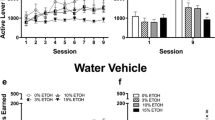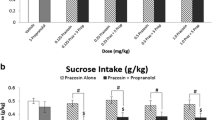Abstract
The role of opioids, dopamine and serotonin in ethanol (EtOH) reward and preference was investigated in non-deprived, Alcohol-Preferring (P), and genetically heterogenous Wistar rats. Operant responding for ethanol was initiated using sweet-solution substitution procedures. The rats were then trained in 30-min daily sessiosn to respond for ethanol (10% v/v) versus water under a two-lever, free-choice contingency. All testing was conducted in the absence of water and food deprivation or addition of sweeteners to the ethanol drinking solution. Rats of both strains developed stable preferences in responding for ethanol over water and consumed ethanol at quantities sufficient to produce pharmacologically relevant mean blood alcohol concentrations (P-Rats: 98±19.6 mg%; unselected Wistars: 41.7±8.5 mg%). InP-rats, systemic naloxone (NAL; 0.125, 0.25 and 0.5 mg/kg) pretreatments resulted in a dose-dependent suppression in responding for both ethanol and water, but did not alter ethanol preference (expressed as percent ethanol of total intake). In contrast, bromocriptine (BRO; 1.0, 2.0 and 4.0 mg/kg) produced a significant, dose-dependent shift in preference from ethanol toward water by inhibiting responding for ethanol while enhancing water consumption. Inunselected Wistar rats, NAL and BRO treatments produced changes in ethanol preference patterns similar to those observed in P-rats. However, compared to P-rats, these changes were smaller and not consistently dose dependent. No changes in ethanol preference and water or ethanol intake were observed with methysergide (MET; 2.5, 5.0, 10.0 mg/kg) in either strain of rat. Together, the results suggest a possible involvement of dopaminergic mechanisms in the reinforcing properties of ethanol. In contrast, the response decrements observed with naloxone may reflect a more general depression in consummatory behavior.
Similar content being viewed by others
References
Altshuler HL, Phillips PE, Feinhandler DA (1980) Alterations of ethanol self-administration by naltrexone. Life Sci 26:679–688
Amit Z, Brown ZW (1982) Actions of drugs of abuse on brain reward systems: a reconsideration with specific attention to alcohol. Pharmacol Biochem Behav 17:233–238
Amit Z, Levitan DE, Brown ZW, Sutherland EA (1977) Catecholaminergic involvement in alcohol's rewarding properties: implications for a treatment model for alcoholics. In: Gross MM (ed) Advances in experimental medicine and biology: biological aspects of ethanol IIIa, vol 85A. Plenum Press, New York, pp 485–494
Brown DR, Holtzman SG (1979) Suppression of deprivation-induced food and water intake in rats and mice by naloxone. Pharmacol Biochem Behav 11:567–573
Brown ZW, Amit Z (1977) The effects of selective catecholamine depletions by 6-hydroxydopamine on ethanol preference in rats. Neurosci Lett 5:333–336
Brown ZW, Gill K, Abitbol M, Amit Z (1982) Lack of effect of dopamine receptor blockade on voluntary ethanol consumption in rats. Behav Neural Biol 36:291–294
Charness ME, Gordon AD, Diamond I (1984) Ethanol modulation of opiate receptors in cultured neuronal cells. Science 222:1246–1248
Cooper SJ (1980) Naloxone: effects on food and water consumption in the non-deprived and deprived rat. Psychopharmacology 71:1–6
Critcher EC, Lin CI, Patel J, Myers RD (1982) Attenuation of alcohol drinking in tetrahydroisoquinoline-treated rats by morphine and naltrexone. Pharmacol Biochem Behav 18:225–229
Daoust M, Chretien P, Moore N, Saligaut C, Lhuintre JP, Boismare F (1985) Isolation and striatal (3H) serotonin uptake: role in the voluntary intake of ethanol by rats. Pharmacol Biochem Behav 22:205–208
Dole VP (1986) On the relevance of animal models to alcoholism in humans. Clin Exp Res 10:361–363
Ettenberg A, Pettit HO, Bloom FE, Koob GF (1982) Heroin and cocaine intravenous self-administration in rats: mediation by separate neural systems. Pharmacol Biochem Behav 13:729–731
Fadda F, Mosca E, Colombo G, Gessa GL (1989) Effects of spontaneous ingestion of ethanol on brain dopamine metabolism. Life Sci 44:281–287
Ferko AP, Bobyock E (1979) Rates of ethanol disappearance from blood and hypothermia following acute and prolonged ethanol inhalation. Toxicol Appl Pharmacol 50:417–427
Froehlich JC, Harts J, Lumeng L, Li T-K (1987) Naloxone attenuation of voluntary alcohol consumption. Alcohol Alcohol [Suppl] 1:333–337
Geller I (1973) Effects of para-chlorophenylalanine and 5-hydroxytryptophane on alcohol intake in rats. Pharmacol Biochem Behav 1:361–365
Gongwer MA, Murphy JM, McBride WJ, Lumeng L, Li TK (1989) Regional brain contents of serotonin, dopamine and their metabolites in the selectively bred high- and low-alcohol drinking lines of rats. Alcohol 6:317–320
Grant KA, Samson HH (1985) Induction and maintenance of ethanol self-administration without food deprivation in the rat. Psychopharmacology 86:475–479
Ho AKS, Tsai CS, Chen RCA, Begleiter H, Kissin B (1974) Experimental studies on alcoholism I. Increase in alcohol preference by 5,6-dihydroxytryptamine and brain acetylcholine. Psychopharmacology 40:101–107
Holtzman SG (1979) Suppression of appetitive behavior in the rat by naloxone: lack of effect of prior morphine dependence. Life Sci 24:219–226
Hubner CB, Koob GF (1989) Bromocriptine produces decreases in cocaine self-administration in the rat. Neuropsychopharmacology (in press)
Hynes MA, Gallagher M, Yacos KV (1981) Systemic and intraventricular naloxone administration: effects on food and water intake. Behav Neural Biol 32:334–342
Imperato A, DiChiara G (1986) Preferential stimulation of dopamine release in the nucleus accumbens of freely moving rats by ethanol. J Pharmacol Exp Ther 239:219–239
Khatib SA, Murphy JM, McBride WJ (1988) Biochemical evidence for activation of specific monoamine pathways by ethanol. Alcohol 5:295–299
Kiianmaa K (1976) Alcohol intake in the rat after lowering brain 5-hydroxytryptamine content by electrolytic midbrain raphe lesions, 5,6-hydroxytryptamine orp-chlorophenylalanine. Med Biol 54:203–209
Kiianamaa K, Fuxe K, Jonson G, Ahtee L (1975) Evidence for involvement of central NA neurons in alcohol intake. Increased alcohol consumption after degeneration of the NA pathway in the cortex cerebri. Neurosci Lett 1:41–45
Kiianmaa K, Andersson K, Fuxe K (1979) On the role of ascending dopamine systems in the control of voluntary ethanol intake and ethanol intoxication. Pharmacol Biochem Behav 10:603–608
Koob GF, Vaccarino FJ, Amalric M, Swerdlow NR (1987) Neural substrates for cocaine and opiate reinforcement. In: Fischer S, Raskin A, Uhlenhuth EH (eds) Cocaine: clinical and biobehavioral aspects. Oxford University Press, New York, pp 80–108
Lawrin MO, Naranjo CA, Sellers EM (1986) Identification of new drugs for modulating alcohol consumption. Psychopharmacol Bull 22:1020–1025
Lester D, Freed EX (1973) Criteria for an animal model of alcoholism. Pharmacol Biochem Behav 1:103–107
Li T-K, Lumeng L, McBride WJ, Waller MB, Murphy JM (1986) Studies on animal model of alcoholism. In: Braude E, Chao HM (eds) National Institute on Drug Abuse Research Monograph, Genetic and biological markers in drug abuse and alcoholism. NIDA, Rockville, pp 41–49
Linseman MA (1987) Alcohol consumption in free-feeding rats: procedural, genetic and pharmacokinetic factors. Psychopharmacology 92:254–261
Lumeng L, Li T-K (1986) The development of metabolic tolerance in the alcohol-preferring P rats: comparison of forced and free-choice drinking of ethanol. Pharmacol Biochem Behav 25:1013–1020
Lumeng L, Waller MB, McBride WJ, Li T-K (1982) Different sensitivities to ethanol in alcohol-preferring and non-preferring rats. Pharmacol Biochem Behav 16:125–130
Lyon M, Robbins TW (1975) The action of central nervous system stimulant drugs: a general theory concerning amphetamine effects. In: Essman W, Valzelli L (eds) Current developments in psychopharmacology, vol 2. Spectrum, New York, pp 79–163
Marfaing-Jallat P, Miceli D, LeMagnen J (1983) Decrease in ethanol consumption by naloxone in naive and dependent rats. Pharmacol Biochem Behav 18:5355–5395
McBride WJ, Murphy JM, Lumeng L, Li T-K (1988) Effects of Ro-15-4513, fluoxetine and desipramine on the intake of ethanol, water and food by the alcohol-preferring (P) and non-preferring (NP) lines of rats. Pharmacol Biochem Behav 30:1045–1050
Mello NK (1973) A review of methods to induce alcohol addiction in animals. Pharmacol Biochem Behav 1:89–101
Murphy JM, McBride WJ, Lumeng L, Li T-K (1982) Regional brain levels of monoamines in alcohol-preferring and non-preferring lines of rats. Pharmacol Biochem Behav 16:145–149
Murphy JM, McBride WJ, Lumeng L, Li T-K (1987) Contents of monoamines in forebrain regions of alcohol-preferring (P) and non-preferring (NP) lines of rats. Pharmacol Biochem Behav 26:389–392
Murphy JM, Waller MB, Gatto GJ, McBride WJ, Lumeng L, Li T-K (1988) Effects of fluoxetine on the intragastric self-administration of ethanol in the alcohol-preferring P line of rats. Alcohol 5:283–286
Myers RD (1978) Tetrahydroisoquinolines in the brain: the basis of an animal model of alcoholism. Clin Exp Res 2:145–154
Myers RD, Critcher EC (1982) Naloxone alters alcohol drinking induced in the rat by tetrahydropapaveroline (THP) infused ICV. Pharmacol Biochem Behav 16:827–836
Myers RD, Melchior CL (1975) Alcohol drinking in the rat after destruction of serotonergic and catecholaminergic neurons in the brain. Res Commun Chem Pathol Pharmacol 10:363–378
Ostrowski NL, Foley TL, Lind MD, Reid LD (1980) Naloxone reduces fluid intake: effects of food and water deprivation. Pharmacol Biochem Behav 12:431–435
Pfeffer AO, Samson HH (1985a) Oral ethanol reinforcements: interactive effects of amphetamine, pimozide and food restriction. Alcohol Drug Res 6:37–48
Pfeffer AO, Samson HH (1985b) Oral ethanol reinforcement in the rat: effects of acute amphetamine. Alcohol 2:693–697
Pfeffer AO, Samson HH (1986) Effect of pimozide on home cage ethanol drinking in the rat: dependence on drinking session length. Drug Alcohol Depend 17:47–55
Pfeffer AO, Samson HH (1988) Haloperidol and apomorphine effects on ethanol reinforcement in free-feeding rats. Pharmacol Biochem Behav 29:343–350
Pulvirenti L, Kastin AJ (1988) Naloxone, but not Tyr-MIF-1, reduces volitional ethanol drinking in rats: correlation with degree of spontaneous preferences. Pharmacol Biochem Behav 31:129–129
Rassnick S, Pulvirenti L, Koob GF (1989) Effects of a novel dopamine agonist, Sandoz 205-152, on ethanol self-administration. Soc Neurosci Abstr 15:251
Reid LD, Hunter GA (1984) Morphine and naloxone modulate intake of ethanol. Alcohol 1:33–37
Rockman GE, Amit Z, Carr G, Brown ZW, Ogren SO (1979) Attenuation of ethanol by 5-hydroxytryptamine blockade in laboratory rats. I. Involvement of brain 5-hydroxytryptamine in the mediation of positive reinforcing properties of ethanol. Arch Int Pharmacodyn Ther 241:245–259
Samson HH (1986) Initiation of ethanol reinforcement using a sucrose-substitution procedure in food- and water-sated rats. Alcohol Clin Exp Res 10:436–442
Samson HH, Doyle TF (1985) Oral ethanol self-administration in the rat: effects of naloxone. Pharmacol Biochem Behav 22:91–99
Sanger DL, McCarthy PS (1982) A comparison of the effects of opiate antagonists on operant and ingestive behavior. Pharmacol Biochem Behav 16:1013–1015
Schulz R, Wuster M, Duka T, Herz A (1980) Acute and chronic ethanol treatment changes endorphin levels in brain and pituitary. Psychopharmacology 68:221–227
Tabakoff B, Hoffman PL (1983) Alcohol interaction with brain opiate receptors. Life Sci 32:197–204
Ushijima I, Mizuki Y, Yamada M (1988) The mode of action of bromocriptine following pretreatment with reserpine and α-methyl-p-tyrosine in rats. Psychopharmacology 95:29–33
Volpicelli R, Davis MA, Olgin JE (1986) Naltrexone blocks the post-shock increase of ethanol consumption. Life Sci 38:841–847
Waller MB, Murphy JM, McBride WJ, Lumeng L, Li T-K (1986) Effect of low-dose ethanol on spontaneous motor activity in alcohol-preferring and non-preferring rats. Pharmacol Biochem Behav 24:617–623
Wise RA (1973) Voluntary ethanol intake in rats following exposure to ethanol on various schedules. Psychopharmacology 29:203–210
York JL (1978) A comparison of the discriminative stimulus properties of ethanol, barbital, and phenobarbital in rats. Psychopharmacology 60:19–23
Yoshimoto K, Komura S (1978) Re-examination of the relationship between alcohol preference and brain monoamines in inbred strains of mice including senescence-accelerated mice. Pharmacol Biochem Behav 27:317–322
Yoshimoto K, Komura S, Mizohata K (1985) Alcohol preference and brain monoamines in five inbred strains of mice. IRCS Med Sci 13:1192–1193
Zabik JE, Blinkerd K, Roache JD (1985) Serotonin and ethanol aversion in the rat. In: Naranjo CA, Sellers EM (eds) Research advances in new psychopharmacological treatments of alcoholism. Excerpta Medica, New York, pp 87–100
Author information
Authors and Affiliations
Additional information
This is publication number 5768 BCR from the Research Institute of Scripps Clinic, La Jolla, California
Rights and permissions
About this article
Cite this article
Weiss, F., Mitchiner, M., Bloom, F.E. et al. Free-choice responding for ethanol versus water in alcohol preferring (P) and unselected Wistar rats is differentially modified by naloxone, bromocriptine, and methysergide. Psychopharmacology 101, 178–186 (1990). https://doi.org/10.1007/BF02244123
Received:
Revised:
Issue Date:
DOI: https://doi.org/10.1007/BF02244123




